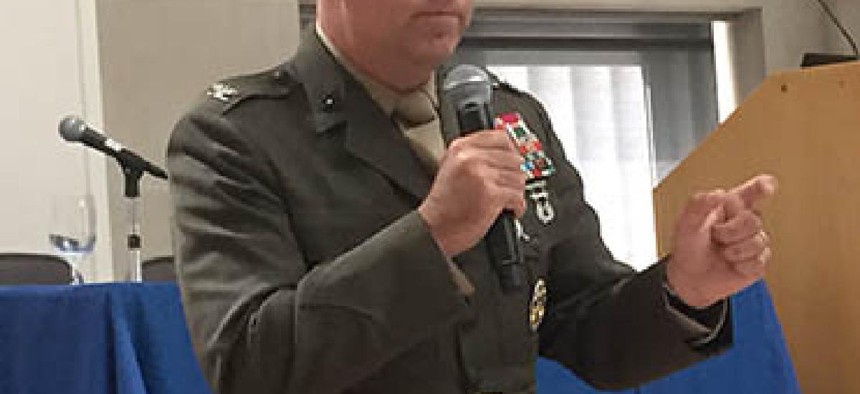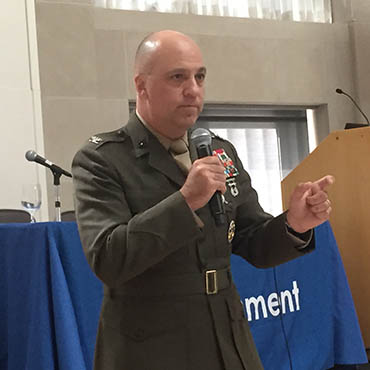USMC colonel calls for shakeup of cyber structure

Marine Col. Gregory Breazile, director of the Corps' C2/Cyber and Electronic Warfare Integration Division, says HQ "is not functionally aligned to support cyberspace operations."

USMC Col. Gregory Breazile says the C2/Cyber and Electronic Warfare Integration Division headquarters "is not functionally aligned to support cyberspace operations.” (Image: Sean Lyngaas / FCW)
A top cyber official in the Marine Corps has called for a shakeup of the service’s structure to better handle the challenges of cyberspace.
“Our headquarters is not functionally aligned to support cyberspace operations,” said Col. Gregory Breazile, director of the Corps’ C2/Cyber and Electronic Warfare Integration Division. “We are fractured. We’ve got a CIO over here, we’ve got intel guys over here. We’re not unified in this effort.”
The growth of the Corps has complicated its cyber footprint: as new organizations in the service spring up, command and control of those organizations relative to the network need to be sorted out, said Breazile, who was speaking at a May 28 conference hosted by the Digital Government Institute in Washington, D.C.
“We realize there’s a lot of risks out there if we don’t get this right,” he added.
Breazile’s comments highlight the growing pains of a service branch grappling with an unfamiliar domain.
The colonel said Corps Commandant Gen. Joseph Dunford is keenly aware of the organizational challenges in cyberspace. Dunford, who has been tapped to be the next chairman of the Joint Chiefs of Staff, issued guidance in January that called for the Corps to use offensive and defensive capabilities in cyberspace. Doing so, the guidance said, required a plan to “enhance command and control and digital interoperability across all elements.”
The Corps in 2013 began operating its own computer networks rather than relying on the privately operated Navy Marine Corps Intranet, and that transition has been central to the service’s challenges in cyberspace. Far-flung bases and regional data centers had different configurations with different gear under the NMCI, and it has taken the Marines time to figure out how to unify the network, Breazile told FCW after the event.
Unifying those systems has “given us a lot of challenges, not only from just the equipment standpoint, but from a training standpoint,” he said, adding that the Corps was tapping contractors for help.
In his remarks at the conference, Breazile said the Marine Corps network was a “mess” shortly after transitioning from NMCI and predicted it will take “many years, unfortunately, to clean it up because it’s not a standardized network.”
The NMCI has proved vulnerable to nation state-sponsored attacks. Iranian hackers in 2013 infiltrated an unclassified portion of the intranet and it took months to drive them out.
NEXT STORY: EDDIE, ICE and apps


